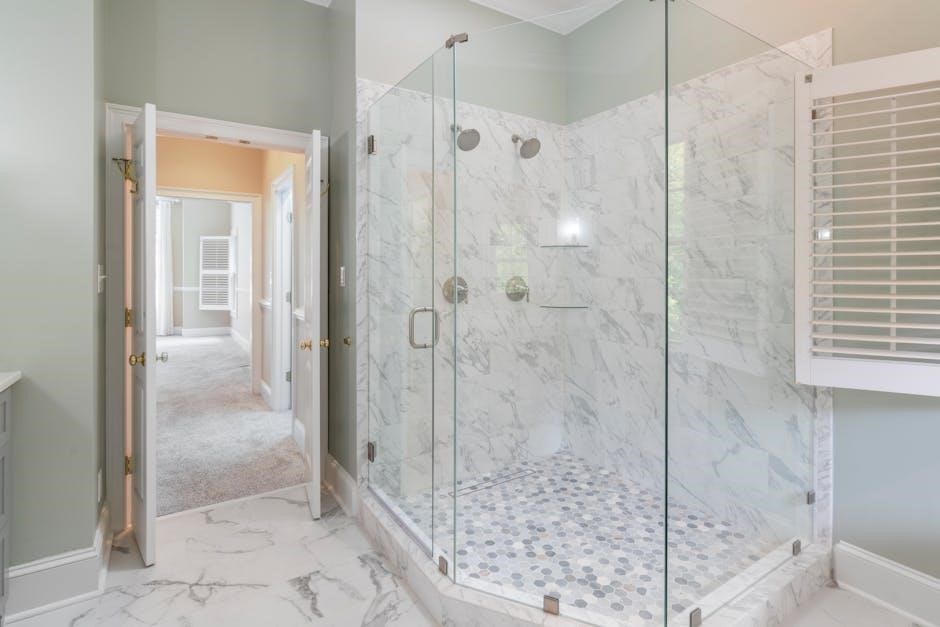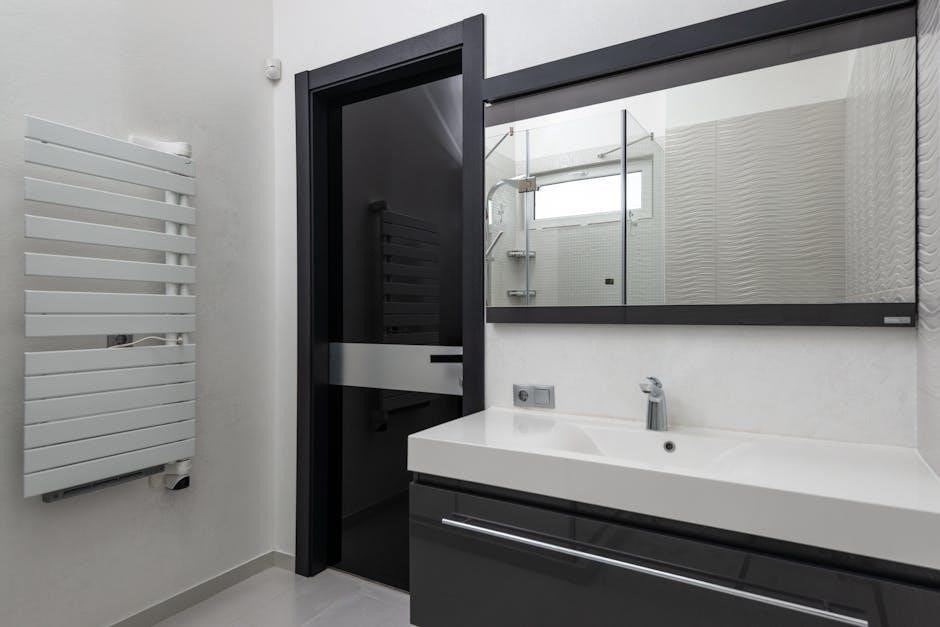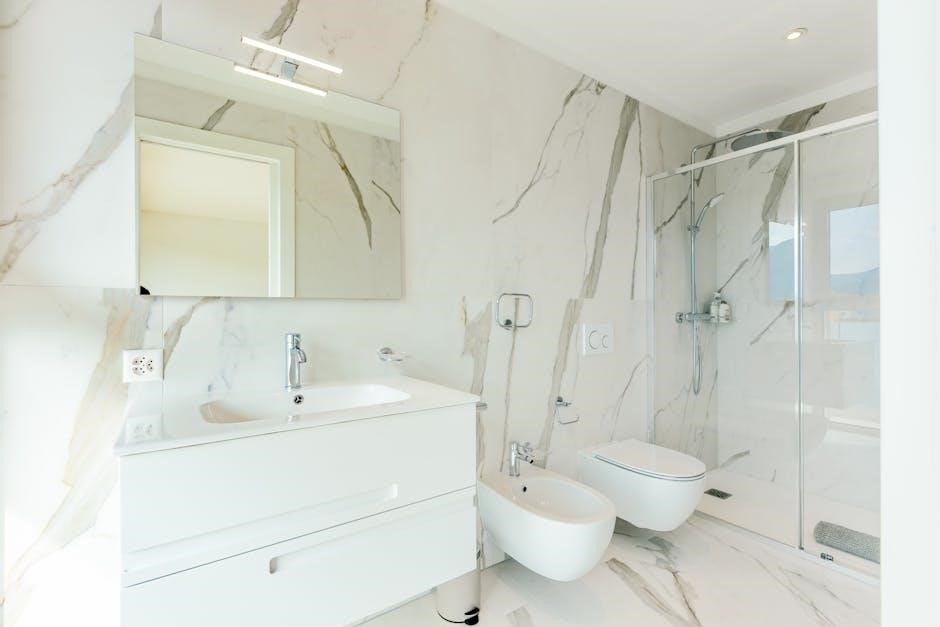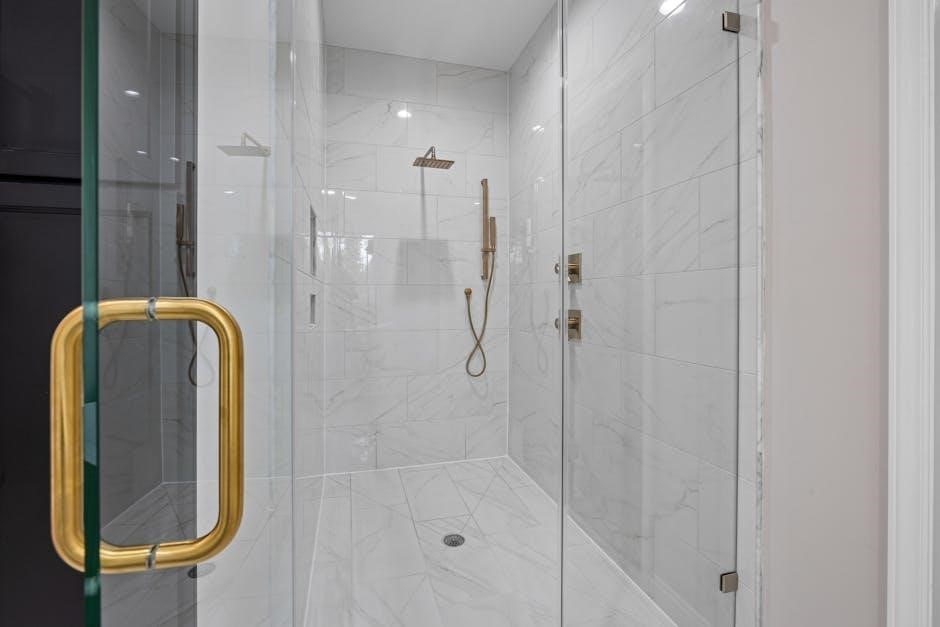Sliding shower door bottom guides ensure smooth operation, align panels, and prevent damage. Made from durable materials like plastic or nylon, they are easy to install and maintain, enhancing functionality and longevity.
Overview of Sliding Shower Door Guides
Sliding shower door guides are essential components that ensure smooth and stable door operation. Designed to fit at the bottom of shower doors, they align panels, prevent misalignment, and reduce wear on hardware. Typically made from durable materials like plastic, nylon, or adjustable designs, these guides are easy to install using adhesive or screw-based methods. They accommodate various door thicknesses and are compatible with top-hung systems. Their primary function is to maintain proper door alignment, ensuring effortless sliding and longevity of the shower enclosure. These guides are crucial for both functionality and aesthetic appeal in modern bathroom designs.
Importance of Bottom Guides in Sliding Shower Doors
Bottom guides are crucial for maintaining the stability and alignment of sliding shower doors. They prevent doors from swinging or shifting, ensuring smooth operation and reducing wear on tracks and rollers. By keeping panels centered, they minimize the risk of damage from misalignment. Additionally, bottom guides enhance safety by preventing doors from potentially tipping or falling. They also contribute to a watertight seal, reducing water leakage. Durable materials like plastic or nylon ensure longevity, while easy installation methods make them a practical solution for homeowners. Overall, bottom guides are essential for both functionality and durability in sliding shower door systems.
Types of Sliding Shower Door Bottom Guides
Sliding shower door bottom guides come in plastic, nylon, and adjustable models, each offering durability, ease of installation, and compatibility with various door thicknesses and systems.
Plastic Bottom Guides
Plastic bottom guides are a popular choice for sliding shower doors due to their durability and ease of installation. Constructed from injection-molded plastic, these guides are often clear or white in color and feature double-sided adhesive tape for quick mounting. They are designed to fit various glass thicknesses, typically up to 1/2 inch, and provide a secure fit to keep doors aligned. Many manufacturers use these guides for their simplicity and effectiveness. Plastic guides are also easy to clean and maintain, making them a practical option for homeowners seeking a hassle-free solution for their sliding shower doors.
Nylon Bottom Guides
Nylon bottom guides are renowned for their exceptional durability and flexibility, making them ideal for heavy-duty applications. Unlike plastic guides, nylon offers superior resistance to wear and tear, ensuring long-lasting performance. These guides are often designed with U-shaped channels to securely hold glass panels in place and are compatible with a variety of glass thicknesses. They are available in different styles, including screw-based models for added stability. Nylon guides are particularly suited for high-traffic bathrooms due to their strength and resistance to mold and mildew. Their versatility and reliability make them a top choice for homeowners seeking a durable solution.
Adjustable Bottom Guides
Adjustable bottom guides offer flexibility and customization, ensuring a perfect fit for sliding shower doors. These guides feature movable components that allow for precise alignment and accommodate varying glass panel thicknesses. Constructed from durable materials like plastic or nylon, they provide stability and smooth door operation. Their adjustability makes them ideal for uneven surfaces or unique installations. Many models come with screw-based systems for secure mounting, while others offer snap-in designs for easy installation. Adjustable guides are particularly useful for heavy-duty applications, ensuring longevity and maintaining proper door alignment over time. Their versatility and adaptability make them a practical choice for diverse bathroom setups.

Key Features of Sliding Shower Door Bottom Guides
Durable materials like plastic or nylon ensure smooth operation. Easy installation via adhesive or screws. Compatible with various glass thicknesses, enhancing alignment and functionality over time.

Material and Construction

Sliding shower door bottom guides are typically made from durable materials like plastic, nylon, or occasionally metal. Plastic guides are often injection-molded for strength and come in clear or white finishes. Nylon guides are prized for their durability and resistance to wear. Many feature double-sided adhesive tape or screw-based mounting options for secure installation. The channels are designed to accommodate specific glass thicknesses, ensuring proper alignment and smooth door movement. These materials and constructions ensure longevity and reliable performance, even with frequent use.
Installation Methods (Adhesive vs. Screw-Based)
Sliding shower door bottom guides can be installed using adhesive or screw-based methods. Adhesive guides feature double-sided tape for quick, tool-free installation, making them ideal for renters or temporary setups. Screw-based guides offer greater stability and durability, suitable for long-term use. Both methods ensure proper alignment and smooth door operation. Adhesive guides are easier to install but may lose grip over time, while screw-based guides provide a secure fit but require drilling. Choose based on door thickness, material, and personal preference for a reliable and lasting solution.
Compatibility with Different Door Thicknesses
Sliding shower door bottom guides are designed to accommodate various door thicknesses, ensuring a secure fit. Most guides are compatible with glass panels ranging from 1/2 inch to 9/16 inch thick. Plastic guides often feature adjustable channels, while nylon guides may offer more flexibility. Some models, like the Prime-Line guide, are specifically designed for 1/2 inch glass, while others can handle up to 7/16 inch. Adjustable bottom guides provide versatility, fitting multiple thicknesses. Proper compatibility ensures smooth operation and prevents door misalignment. Always measure door thickness accurately to select the right guide for optimal performance and stability.

How to Choose the Right Bottom Guide
Selecting the right bottom guide involves measuring door thickness, considering material durability, and ensuring compatibility with your shower door system. Plastic guides are cost-effective and easy to install, while nylon guides offer greater durability. Adjustable guides provide flexibility for varying door thicknesses. Choose guides that match your door’s thickness, typically ranging from 1/2 inch to 9/16 inch. Consider the door type (top-hung or bottom-mounted) and brand reputation for quality. Proper fit ensures smooth operation and prevents misalignment, enhancing the shower door’s functionality and longevity.

Measurements and Fitment
Accurate measurements are crucial for proper fitment of sliding shower door bottom guides. Ensure the guide’s channel width matches your door’s thickness, typically ranging from 1/2 inch to 9/16 inch. Measure the door’s edge to confirm compatibility with the guide’s opening, which can vary between 5/8 inch and 1.62 inches. Proper alignment with the track system is essential to prevent misalignment and ensure smooth sliding. Double-check the guide’s length and width to fit seamlessly with your shower door setup, ensuring stability and functionality. Correct measurements prevent gaps and wobbling, enhancing overall performance and durability of the shower door system.

Material Selection Based on Usage
Choosing the right material for sliding shower door bottom guides depends on usage and durability needs. Plastic guides are cost-effective, lightweight, and easy to install, making them ideal for standard applications. Nylon guides offer superior durability and resistance to wear, suitable for frequent use. For heavier glass panels or high-traffic areas, metal guides provide exceptional strength and longevity. Consider the door’s thickness and material when selecting, as compatibility ensures optimal performance. Proper material selection enhances the guide’s functionality, ensuring smooth door operation and extending the lifespan of the shower door system. Prioritize durability and moisture resistance for long-term reliability.
Brand and Quality Considerations
When selecting sliding shower door bottom guides, prioritize brands known for durability and quality. Reputable brands like Prime-Line, CRL, and Gordon Glass offer reliable products. High-quality guides are constructed from durable materials like nylon or metal, ensuring longevity. Look for rust-resistant finishes and smooth-gliding mechanisms. Consider the thickness tolerance and adjustability features to ensure compatibility with your door system. Reading reviews and product ratings can help identify trusted brands. Investing in a reputable brand enhances performance and reduces the need for frequent replacements, ensuring your shower door operates smoothly for years. Quality guides are a critical investment for long-term functionality.

Installation and Maintenance Tips
Ensure the track is clean and dry before installing guides. Use double-sided adhesive tape or screws for secure mounting. Regularly clean guides to prevent debris buildup. Lubricate moving parts for smooth operation. Inspect and replace worn-out guides promptly to maintain door alignment and functionality. Proper maintenance enhances longevity and ensures seamless door movement.
Step-by-Step Installation Guide

Install sliding shower door bottom guides by first cleaning the track area to ensure a secure fit. Peel the backing from the double-sided adhesive tape on the guide and align it with the track. Press firmly to secure. For screw-based models, drill pilot holes if needed, then screw the guide into place. Ensure proper alignment with the door’s bottom edge. Test the door’s movement to confirm smooth operation. If using snap-in guides, simply press them into the track until they click. Finally, inspect the installation to ensure stability and proper functionality.
Cleaning and Maintenance Practices
Clean sliding shower door bottom guides regularly to prevent dirt buildup. Use mild soap and warm water with a soft cloth to wipe down the guides. Avoid harsh chemicals, as they may damage plastic or nylon materials. Dry the area thoroughly after cleaning to prevent mineral spots and bacterial growth. Inspect the guides for wear and tear, replacing them if damaged. For adhesive-based guides, ensure the track is clean before reattaching. Regular maintenance ensures smooth door operation and extends the lifespan of the guides. Lubricate tracks with silicone spray if needed, but avoid oil-based products that attract dirt.
Troubleshooting Common Issues
Common issues with sliding shower door bottom guides include misalignment, noise, or difficulty sliding. Check for dirt or debris in the track and clean thoroughly. If the door sags, adjust the rollers or guides. Noise may indicate worn-out parts or lack of lubrication. Inspect the guides for cracks or damage and replace them if necessary. Ensure the door is properly aligned with the track to avoid uneven movement. If adhesive-based guides lose grip, clean the area and reattach. Addressing these issues promptly prevents further damage and ensures smooth door operation.